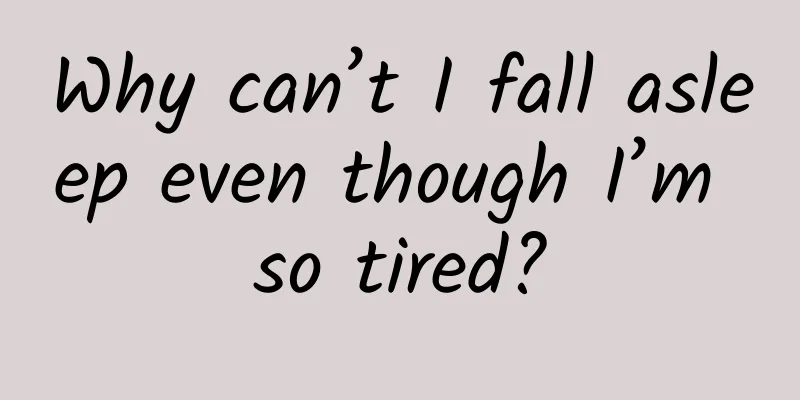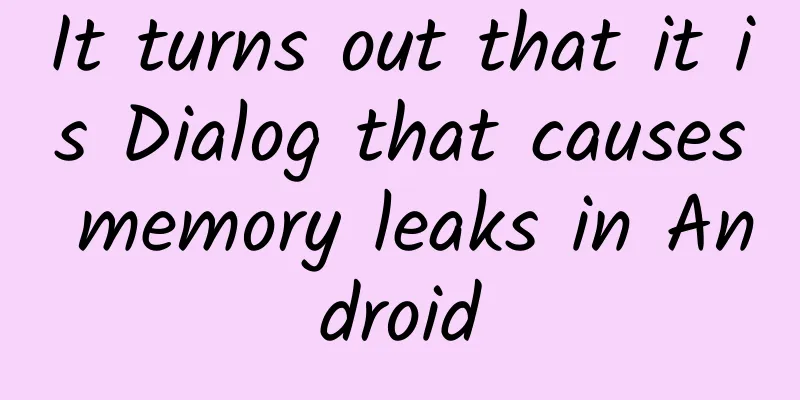Why can’t I fall asleep even though I’m so tired?

|
Although many people suffer from insomnia, few people have really thought about questions such as "Why do we need to sleep?" or "Why don't we want to sleep?" However, people often have confusion like "Why can't I fall asleep even though I'm obviously tired?" because they don't know enough about sleep. When we don’t sleep well, we often blame the environment, such as noise, light, mattress, and the softness or hardness of pillow. Of course, these factors definitely have an impact on sleep, but the fundamental reason for poor sleep is that the brain nerves are “at fault”. Neuroscientist Russell Foster discovered through research that sleep behavior is not produced by a single structure within the brain, but is generated and stopped by the interaction of different parts of the brain. So what exactly affects our sleep? What is the relationship between sleep and wakefulness? 01 Being tired does not mean being sleepy People often confuse the words "sleepy" and "fatigue" and treat them as the same thing, but they are not. Many people say they are very sleepy, but they cannot fall asleep after going to bed because their desire to sleep is very low, not sleepy. Being exhausted does not mean being sleepy. The fatigue scale is an effective assessment tool for evaluating an individual's fatigue level. Please judge the degree of each of the following statements about fatigue to assess your level of fatigue. Scoring standard: 1 to 7 points Strongly disagree is 1 point - Strongly agree is 7 points 1 2 3 4 5 6 7 If the average score is greater than 4, it means you need to replenish your energy, not necessarily sleep, but take a rest. We often feel tired, but fatigue is not necessarily caused by lack of sleep. There are many culprits that cause fatigue, such as: Hypothyroidism Vitamin B12 deficiency Iron deficiency Anemia depression diabetes heart disease All of the above diseases may cause fatigue. The human body is not like a mobile phone that displays the remaining battery power. Therefore, to determine whether you need to replenish energy, you need to observe yourself carefully and understand yourself. If you feel that you can't muster the energy to run, work, or go on a date, in addition to considering sleep problems, you also need to consider whether the fatigue is caused by other reasons. Image source: pexels 02 How the brain makes us sleepy The two major systems of our brain, the "homeostasis system" and the "circadian rhythm system", interact with each other to make us sleepy. Two chemical substances, "adenosine" and "melatonin", play an important role in these two systems. If enough adenosine accumulates during the day, we will start to feel sleepy at night. In addition, the eyes cannot sense light, and the suprachiasmatic nucleus (SCN) is no longer inhibited, which prompts the pineal gland to release melatonin. The accumulated adenosine and melatonin will bring us a wonderful sleep. The brain secretes a chemical called adenosine, which is an important substance in the homeostatic system. Adenosine is a substance that can induce sleepiness. The longer we are awake, the more adenosine accumulates in the brain, and the sleepier we feel. An important player in the circadian system is melatonin, which is secreted when we are in a dark environment. When the eyes cannot sense light, a group of cells, essentially the retinal photoreceptor ganglia, are responsible for receiving signals and sending them to the suprachiasmatic nucleus (SCN). The SCN is like a timer in the brain, prompting the pineal gland to release melatonin. During the day, the powerful homeostatic pressure that promotes sleep is constantly suppressed by the SCN, so we can overcome sleepiness and accomplish other things. However, as bedtime approaches, the SCN is no longer suppressed, melatonin is released in large quantities, and sleep follows. Image source: pexels 03 How the brain keeps us awake We always think that the opposite of sleep is wakefulness. In short, people think that sleepiness and wakefulness are like light switches, either on or off. When you are awake, your brain is in the "lights on" state, and when you sleep, your brain is in the "lights off" state. However, the process by which the brain controls sleepiness is completely different from the process by which it controls wakefulness. Moreover, when people sleep, their brains are not always in the "off" state. Since Freud's time more than 100 years ago, studies have shown that people retain some consciousness during sleep and sometimes even under surgical anesthesia because some stimuli are still transmitted to awareness. Just like when we feel sleepy, our brains also secrete some chemicals to keep us awake. The three main substances that keep us awake are histamine, dopamine, and orexin. The role of histamine in the brain is very complex. There are three types of histamine receptors with different distribution patterns in the brain. The HR-1 receptor is excitatory after activation, which can mediate the release of histamine associated with wakefulness and the sedative effect of antihistamines. The HR-2 receptor is a metabolic receptor that mainly regulates long-term changes in neuronal impulses. The HR-3 receptor is mainly located in histamine neuron cells and its function is to inhibit the synthesis and release of histamine. Dopamine is also a wakefulness-promoting chemical. Dopamine is released in a circadian rhythm, reaching its highest level during the day and dropping to its lowest level at night. It's so perfect. Does dopamine have other functions besides promoting wakefulness? Dopamine is a neurotransmitter that transmits pleasure, so whenever we do something fun, our brain releases a small amount of dopamine. In addition, dopamine plays many roles in the human body, one of which is to regulate muscle activity. Parkinson's patients lack dopamine in their bodies, so its importance in promoting smooth and coordinated human movements is highlighted; many Parkinson's patients also have sleep problems due to dopamine deficiency. These patients are likely to suffer from REM behavioral disorder, that is, normal paralysis during REM sleep is impaired, resulting in chaotic dreams; in addition, Parkinson's patients usually also suffer from restless legs syndrome, their limbs twitch frequently at night, and they are extremely sleepy during the day. The resulting desire for sleep usually causes irregular random sleep. It is precisely because dopamine plays a pivotal role in keeping the brain awake that patients with mild Parkinson's are always drowsy. The third wakefulness-promoting chemical is orexin. Orexin and hypocretin were discovered and named by two independent research groups in 1988. They are actually the same chemical, but the name orexin was later decided because of disagreements over the definition of hypocretin. In mice, intracerebroventricular injection of nanomolar concentrations of hypocretin can promote wakefulness, reduce REM sleep, and leave deep sleep unchanged, affecting neuroendocrine balance. Hypocretin protein precursors are peptides secreted by the dorsolateral hypothalamus. Since the effects of the lateral ventricles are more pronounced than those of the fourth ventricle, some manifestations are confined to the basal forebrain. These views have led to the currently widely accepted view that orexin neurons are responsible for the transition from wakefulness to sleep. Without this substance, the transition is unstable, and the transition phase may occur at an inappropriate time, resulting in sleep abnormalities. For example, orexin deficiency is the cause of narcolepsy, because without sufficient orexin, narcolepsy patients will experience extreme sleepiness. Image: pexels Our wakefulness and sleep under normal circumstances, when we wake up in the morning, the individual's alertness reaches a baseline level. Because the previous night's sleep reduces the level of adenosine in the brain, the individual's sleepiness is also lower. As the day goes by, people's sleepiness level gradually begins to increase after being awake for a long time. It is under the action of adenosine, melatonin, histamine, acetylcholine, dopamine, orexin and other chemicals that we can stay awake during the day and sleep at night, maintaining a steady-state balance between wakefulness and sleep. In the book on sleep science, sleep is explained in this way: sleep is a highly conservative life phenomenon. Therefore, if we take a nap during the day, then if we don’t accumulate enough adenosine at night, it is likely to cause insomnia. If the blue light of electronic products used before going to bed inhibits the secretion of melatonin in the brain, it may also cause us not to be sleepy. Then, what about another situation? Although we did not sleep during the day and exercised, we felt very tired. We should feel sleepy and want to sleep at night, but once we go to bed, the sleepiness disappears without a trace, just like a person trapped on a desert island and dying of starvation, but refuses to rescue his food. Why? Because alertness increases when lying down to sleep. It’s not that we are not sleepy, but the degree of alertness is greater than the degree of sleepiness, so the brain is awake. As for why alertness suddenly increases when lying in bed? Maybe you should check your sleeping habits. For example, if you are used to thinking in bed, you worry about not being able to sleep as soon as you enter the bedroom. These psychological cues will bring pressure to fall asleep, and then the brain begins to secrete substances that produce alertness. So, the answer is imaginable. |
>>: Is it safe to use the hand sanitizer in public toilets?
Recommend
What are these "little bumps" on your scalp? How can you prevent them? Here are the answers...
This article was reviewed by: Xiaobo Zhou, Doctor...
Live streaming car sales gone astray: 4S stores turned into talent shows, making anchors popular but car dealers suffering
A few years ago, live streaming became popular, a...
After watching 1,000 videos, we summarized 10 ways to make money on Douyin!
In the past two days, I have watched more than 1,...
Youdao Dictionary Pen Professional Edition Review: Covering 2.4 million words including Oxford Advanced Learner's Dictionary, a learning tool for "study, work, and life"
For those who are learning a foreign language, th...
Wuhan University Sakura live broadcast schedule announced: When will it start and end? Attach specific time
March every year is the season to go to Wuhan to ...
Third-party login
Source code introduction: Because it involves the...
How to operate an APP software online?
In general, app operations are divided into two a...
4 core strategies for Spring Festival marketing promotion
Another Spring Festival is approaching, and a lar...
A giant "bubble" is hidden in the Cygnus. How far is Lasso from solving the "mystery of the century" of the origin of cosmic rays?
Recently, scientists at the LHAASO cosmic ray obs...
How long is the life of a smartphone? It can be long or short.
With the development of technology, smartphones h...
NSTimer in iOS
[[139776]] When I was organizing the company'...
Where can I buy fresh dog meat?
Where should I buy dog meat online? Where can I...
DedeCMS template common tags
I have been searching for the commonly used tags ...
GEO Data Analysis Video Course Series
GEO Data Analysis Series Video Course Resource In...









